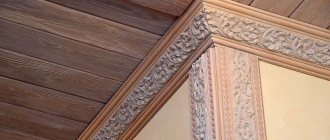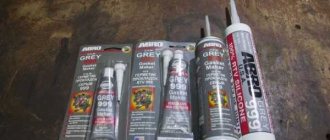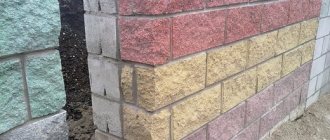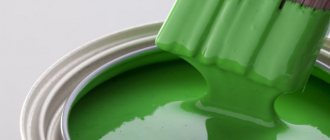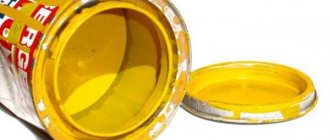Production and origin
Acrylic paints appeared on the market relatively recently. Scientists, in the process of splitting acrylic acid, were able to isolate a substance that became the basis for the manufacture of the polymer. It is a pure synthetic material. It has a transparent texture and excellent technical properties. The material does not have a pungent odor. It is very durable, tolerates thermal changes well, and is not afraid of ultraviolet radiation.
Using acrylic resins, manufacturers have learned to produce paints and paints. They prepare a solution, add a polymer dispersion, a binder, and a coloring pigment to it. The result is a material, after application of which a film is formed on the surface being treated that can protect against external factors. This paint adheres very well to the base and has a high degree of adhesion. Its quality depends on the type of acrylic resin and the fillers used. With their help, the viscosity of the paint and its matting are “formed”.
Polymer base for the production of acrylic paints Source svopi.ru
This indicator is adjusted by adding a solvent. When deciding how to dilute acrylic paint, you need to carefully study the manufacturer's instructions. The main parameters of the composition are indicated there, the scope of its use is indicated, and the main stages of preparing the paint for construction work are listed. The composition of acrylic paints provides their advantages:
- They are environmentally friendly and do not contain substances hazardous to human health.
- They are easy to work with, the compositions are applied in an even layer and dry quickly.
- The paints are odorless, so you can work with them even indoors.
- The materials are not prone to fire, they do not contain flammable substances.
- The ability to add pigments allows manufacturers to produce paints in a wide color palette. Today, using them you can not only paint various types of surfaces, but also create colorful paintings. What makes artists who paint walls and ceilings happy?
Acrylic paint colors Source giveart.ru
- The time for complete drying of one layer is three hours.
- After application, a film that is resistant to abrasion is formed on the surface. The color does not fade in the sun.
- The painted surface does not lose its attractiveness for ten years.
- The composition of the paint is unique; after application, its layer reliably protects the surface from moisture, while it allows air to pass through well.
- Painted areas are easy to clean, dirt particles do not stick to them, so the maintenance process is noticeably simplified.
Versatility and versatility provide a wide range of applications. Experts, talking about what acrylic paints can be used for, draw attention to the fact that they can paint metal and wood, concrete, a layer of decorative plaster and even fabric. With their help, tuning of passenger cars is carried out. They are used by manicurists and pedicurists to create amazing nail designs. There are restrictions on some types of plastic, but otherwise there are no prohibitions.
Wall art painting Source remstatus.ru
See also: Catalog of house projects for which painting was used.
Features of working with acrylic
Beginning artists approach working with acrylic paints with a certain caution, having heard a lot about the features of this material. Indeed, certain knowledge and skills will be needed.
The main difficulty that you will have to face is the irreversible and fairly rapid drying of the paint and the hardening of the polymer.
If you lack experience, you can waste valuable time and miss the opportunity to correct defects in strokes.
In this regard, you should be guided by basic techniques and recommendations from professional artists.
- It is recommended to begin to understand the practice of working with acrylic paints using the “wet on” technique. This technique is no different from the technique of working with watercolors. The paper and the brush itself are pre-wetted.
- The dry writing technique requires the presence of at least two brushes. The first brush is used to apply the main stroke. The second brush should be clean and damp. It is designed to adjust and correct the stroke.
- Acrylic paints allow for double brush strokes. This is a unique technique in which two colors of paint are applied to the brush at once. It is mainly used in artistic painting.
- The glaze technique when using acrylic turns out to be very successful. The technique itself consists in the fact that the image is formed layer by layer. Since acrylic film does not allow moisture to pass through after drying, this quality allows you to form a second and even third layer without mixing shades.
- Another technique that is suitable for acrylic is impasto. It is usually found in impasto oil painting. With a sufficiently high viscosity of acrylic paint, you can make textured and relief strokes. Acrylic in tubes is very suitable for working with a palette knife. It is believed that the impasto technique is the opposite of glaze.
Acrylic allows you to work with a spray gun, but the paint must be diluted with water.
Water is also used when the artist needs a lot of time to make corrections and wants to slow down the drying process.
If the paint on the palette has not completely dried, it can be “revitalized” by adding water. It is important to adhere to the following principles:
- Only distilled water should be taken;
- If water is drawn from the tap, then it must stand for 24 hours before use;
- The paint is diluted in a clean container.
The proportions of paint and water depend on the chosen technique and the consistency of the starting material.
For example, for glazing the water/paint ratio is 5 to 1, and the final layer is formed with a composition of 1 to 2.
A set of 8 – 10 colors of acrylic paint is quite suitable for a full-fledged work. You can get a dozen additional combinations from white, black, red, yellow and blue.
Types of paints
By mixing different proportions of the main components and adding additives, it is possible to create compositions for different surfaces. Acrylic paints for exterior use are available for sale. They contain substances that improve resistance to fading in the sun; their consistency is more similar to enamels. They are used to paint any surface that is located on the street: house facades, fences, gates.
In interior paints there are significantly fewer components that improve UV resistance. Antiseptics and fungicides can be added to them and prevent the formation of mold in places with high humidity.
If long-term work is planned, additives are added to the compositions to slow down the drying of the paint. They have a gel consistency. By using such components, it is possible to make technical breaks, and they do not in any way affect the quality of the finishing coating.
Weather-resistant acrylic facade paint Source ozon-st.cdn.ngenix.net
Note! Adding components can make the paint structure matte or glossy. Therefore, this must be taken into account before using them.
Metal paints are usually sold in aerosol form. To apply other types, it is better to use brushes with synthetic bristles or hard rollers.
See also: Catalog of companies that specialize in paints and varnishes and finishing works
Types of acrylic-based paints
Since the material has a wide range of applications, it is divided into paints for exterior, interior, automotive or painting use. The facade coating consists of additives that increase resistance to ultraviolet rays, humidity, and other weather factors. Such compositions are considered resistant to abrasion; they are used to cover fences, gates, facades, and other premises located on the street.
Material for internal use has less resistance to external factors, is applied smoothly, adheres well to the surface, and is durable. They are used to cover floors, ceilings or walls. The universal mixture is used for interior and exterior work. Using acrylic-based paints, you can make a masterpiece of art out of a car; you can paint various pictures and patterns. The material is also used for applying designs to nails, fabrics, and other surfaces.
Paint may differ in different characteristics, resistance to moisture, mechanical damage, aggressive substances, and ultraviolet rays. You can choose a glossy, matte or silky-matte look, it depends on personal preference and the interior. Acrylic paint can be used for wood, metal, wall and ceiling surfaces; there are universal type compositions.
Application technology
In order to obtain a high-quality result, the surface to be painted must first be cleaned of dirt and dust, and then primed. To do this, it is better to use a special composition or white acrylic paint diluted in half with water. If you ignore this process, the consumption of the finishing coat will double (both acrylic paint on wood and any other type are well absorbed into the base). If it is pre-coated with primer, much fewer layers will need to be applied.
If there is an old layer of paint, it is better not to experiment, but to remove it completely with a spatula. If this work is not done carefully, the result will not please you: the acrylic compositions are applied in a very even thin layer, and the presence of any defect is only emphasized and exposed.
Preparing walls for painting Source mtdata.ru
The direction in which the first layer of paint is applied does not matter. If the material is used to decorate walls or ceilings, it is better to apply the finishing layer towards the window. Then the finish will look perfect.
Before applying acrylic, glass and metal surfaces must be wiped with an alcohol composition, which allows the surface to be degreased. Then the paint layer will lie flat, and after drying the coating will be very strong and durable.
To choose the right color, you need to try on a separate piece of the material being processed. The fact is that acrylic paint for wood, metal, glass becomes a little darker after drying. It is important to pay attention to the structure of the composition. It can be glossy, matte, translucent and completely transparent. After hardening, it will be impossible to correct defects.
Acrylic paint darkens slightly after drying Source roomester.ru
Features of artistic painting
Each stage in coloring is of great importance, since an error at one of them or a violation of the work technique can lead to a poor-quality result of the entire process.
Applying artistic painting to a surface using acrylic paints requires pre-treatment.
To do this, the coating is removed from the area where the painting will be, treated for defects and a layer of finishing putty is applied, and painting is already done on it. To protect the painting from quickly losing its original appearance, after the acrylic paints have dried, it must be varnished.
How to prepare the composition for painting
Any enamels must be diluted before application. Not everyone knows how to dilute acrylic paint. The manufacturer does not always indicate this item in the technical data sheet. If there is no additional information, you can dilute the paint with plain water. When the 1x1 ratio is selected, the ideal composition for priming the base is obtained.
If you need to apply a very thin layer that will lie evenly on the surface, experts advise adding two parts of water (200 ml per liter). The more water, the thinner the paint layer will be.
Note! The paint must be diluted in a separate container. You cannot pour water into the jar straight away. In such a situation, it will be difficult to control the consistency of the finished composition. Acrylic diluted with water cannot be stored. Once dry, it becomes unusable.
Water is the best base for acrylic paints Source kraskaok.ru
Hot boiled water is the best thinner for acrylic paints that are dried and unused. To “reanimate” them, you need to grind the dried paint into powder, and then pour boiling water into it. Leave for a few minutes, drain, and repeat the procedure again. After the paint has softened well, excess water is poured out, everything that remains in the container is thoroughly stirred. Of course, after such “reanimation” the material partially loses its properties, so experts do not recommend using it for painting “ceremonial” places. However, if you need to improve the appearance of an old shed, paint will do just fine.
Tools and materials
The first thing you need to do is make sure that the palette contains the right shades. If you have no experience in mixing paints or doubt that you will be able to get the color right, then you can use ready-made palettes, since acrylic paints are sold in a wide range, and you will probably find a tube of paint of a suitable color.
Beginning artists are recommended to practice their skills in obtaining color shades using primitive children's coloring books.
You can purchase a standard set of paints from basic colors and start mixing them in pairs. You need to start practicing on small formats. Only after understanding the theory of color combinations can you begin format work. Regardless of your experience and chosen technique, it is important to remember one rule - acrylic paints should not be left open.
Absolutely any brushes are suitable for working with acrylic paints. You can try your hand and evaluate the results of working with natural and synthetic brushes.
Acrylic in tubes is more convenient to use with plastic brushes, as it is thicker.
Paints diluted in water to a liquid state require a softer pile (protein or columns).
If you have chosen acrylic paints as the main material, it means that you are ready to experiment with texture. For this you will need a palette knife.
You can start with a regular diamond-shaped spatula, gradually developing the technique of applying strokes to the canvas.
Water should always be on hand, especially if you have chosen the “wet” painting technique. A spray bottle is suitable for wetting the canvas, but you also need to prepare a regular bottle of water.
An experienced artist always has a palette in his arsenal, that is, a tablet on which he prepares paints. If you don’t have such a tablet yet, you can use regular plastic disposable plates. The two-paper method will help retain moisture in the paint. The first paper is laid on the palette.
It must be fibrous to absorb moisture.
Ink is applied to this paper. The top of the paint is covered with parchment paper. Moisture from the bottom layer gradually penetrates the paint, preventing it from drying.
The acrylic paint thinner can simultaneously function as a retarder. By adding thinner to the paint, the artist gets a few minutes of extra time to work out the details of the drawing, shade the paint, or make corrections.
It is important to choose the right thinner for a particular type of paint, and for this you need to study the instructions.
There is a list of secondary materials that may be needed during the work process, but are not required.
These include:
- Water in a large container for washing the palette and brushes;
- Paper towels or napkins;
- Fine-grained sandpaper;
- Pencils, felt-tip pens or markers;
- Glue;
- Spray gun or airbrush;
- The basis.
Briefly about the main thing
Acrylic paints are water-dispersion compositions that contain polymers, water, pigments and additives that improve the technical properties of materials. They differ from similar products in that they help form a very thin color layer that is resistant to moisture and ultraviolet radiation. It allows air to pass through well. Has high wear resistance. You can paint any surface with acrylic paints. They have one drawback - the high price. But greater durability more than compensates for any expenses.
Ratings 0
Acrylic paints - colors and textures
The vast majority of acrylic solutions are produced in white, but any buyer can easily change the color by using different types of colors. You can also use initially multi-colored compositions that are produced by individual manufacturers.
Acrylic has uneven whiteness. Technologists distinguish three levels of it:
- super white material;
- milky white;
- regular white.
To ensure that the color matches your expectations and that the information from the manufacturer is not misleading, you need to check the paint when purchasing, comparing its tone with the color of high-quality white paper.
It should be noted that painting with acrylic compounds creates either a matte or glossy texture. Matte painting is recommended if you need to mask minor deformations or cracks in the base.
Gloss is preferable if you plan to create a colored surface that is large enough and even. Experts recommend using this option also for non-residential rooms in the house. Textured decor involves the creation of relief designs and artistic compositions, but it is not recommended for non-residential space. Still, few people will appreciate such delights.
By painting a wall silver, you can emphasize the stylistic advantages of other parts of the room. This tone is compatible with any design solutions and a number of other colors. What is important is that silver colors visually raise the ceiling, which is something that owners of small-sized homes should take into account.
Mother-of-pearl paint is designed to add volume to the room, and its modification, such as “chameleon,” adds a number of interesting shimmers. Both options look attractive both on wood and on wallpaper for painting.
To create a bright and attractive composition, you don’t have to limit yourself to mother-of-pearl. Paint containing glitter creates an equally interesting interior. But adding shiny elements should be done in moderation. It is not advisable to paint a wall so brightly that it dazzles at first glance. You can show originality by using glitter of various types and colors different from the main color.
A black wall is the exact opposite of the colored and shiny varieties. This is a sharp, even radical stylistic decision. As with any powerful design tool, this option must be approached with caution, carefully weighing all the positive and negative aspects. Professionals quite often combine the black color of one or two walls with white decor or bright surroundings, but for those who do not have special knowledge and skills, such a step is not recommended.
If we are not talking about the palette of paints, but about ways to visually emphasize paintings, it is worth paying attention to the fact that it is advisable to coat compositions based on acrylic paint with a protective transparent varnish. This will help them maintain an attractive appearance and will not deteriorate their external qualities.
Tools needed to apply acrylic composition
To achieve an impeccable result, you need to stock up on a set of high-quality painting tools, which includes the following items:
- Roller with soft faux fur. The tool should absorb the paint well and hold it inside without splashing.
- A set of brushes with soft bristles for finishing corners and joining ceilings with walls in hard-to-reach places.
- A tray with a grooved surface for rolling out the roller and removing excess paint from it.
Roller with tray
If several rooms in an apartment or house are to be painted, and the total ceiling area exceeds 100 - 150 m2, an advisable solution would be to use a spray gun, which will ensure uniform application of a layer of acrylic paint in a short time.
Consumer reviews, prices
Today there are a large number of brands under which acrylic paints are produced. Consumer reviews left in various sources note the good quality of products such as Kolorit, Dufa, Belka, Caparol. They have been producing their products for a long time.
The price depends largely on the displacement. For construction and repair work, there are cans from 0.5 to 4.5 liters on sale. The price for 4 liters is in the range of 200-300 rubles. If you need to paint fairly large areas, use 15 liter canisters. Their cost is approximately 600-1000 rubles.
For painting walls, products are available in tubes of 60, 140, 205 ml. Their prices vary greatly. It depends on the manufacturer and the components included.
Having familiarized yourself with such a coating as acrylic paint for ceilings and walls, you can choose and apply the product correctly to the base. This is a good solution for decorating the interior of any room.
Main characteristics
Acrylic paint for ceilings and walls has been used in interior decoration for more than 50 years. It is applied to plastered, brick, concrete or wooden surfaces.
The paint can be white or colored. This allows you to create a variety of images. Acrylic paint is a water-dispersed composition. Polyacrylates, as well as their copolymers, are used as the basis for their production. Such substances help form a film on the surface.
The composition of acrylic paint contains 3 main components. Firstly, it is an acrylic polymer emulsion, secondly, a color pigment, and thirdly, water. Such components make the decorative coating suitable for washing. After application it dries quickly. This makes the presented variety of paints in demand.
Preparing paint for further use
Acrylic water-based paint can be used in the form in which it is sold. However, in some cases it is more advisable to dilute it.
If you plan to apply layers using the spraying method, you simply cannot do without it. Paint that is properly prepared for application is more fluid. Its layer is thinner, but it is distributed more evenly.
There are special formulations for dilution on sale. They help preserve the texture of the coating, be it gloss or matte surface.
Each manufacturer indicates on the jar of the product instructions for its use. By observing the required proportion, you can achieve a very good result.
There is another way to prepare the decorative base for use. To do this, water is added to its composition. The product will become more fluid if you pour 10% liquid into it. If you dilute more, the layer will be too thin. The work will take a long time.
The manufacturer indicates on the packaging how to dilute the product. Acrylic paints, the colors of which are selected in the store, are very diverse. Sellers will help you create the required shade using special equipment.
You should save the tinting code if you need to purchase another product of the same type. But it is better to take coverage with a reserve. Even in factory conditions, the shade may vary slightly for different batches.
Painting walls
Painting walls with acrylic paint is a task that does not require extensive professional training. You will need the simplest tools:
- brushes,
- paint roller,
- paint tray,
- masking tape.
If the farm has a spray gun, you can also use it. It is not necessary to purchase this device specifically for interior work.
Use adhesive paper tape to cover baseboards, door jambs, slopes, and joints with the ceiling. The finished water emulsion or diluted acrylic dispersion is thoroughly mixed with a construction mixer or drill with an appropriate attachment.
The paint is poured into a tray, and all “inconvenient” places are painted with a brush: corners, joints, areas behind pipes, around switches and sockets.
The coat of the roller is impregnated with the coloring composition, the excess is removed and painting begins from the top or from the middle, making movements in the vertical direction and down alternately or in a w-shape (see video). In this way, paint the entire surface.
After the first layer has dried completely, you can apply the second. Usually this is quite enough to obtain an even tone.
Material consumption per 1 sq. m
Usually one can of material is enough for 3.5-4.5 square meters of wall. But the cost may depend on the performance of the work itself. If the painting is done poorly, each area is painted poorly and unevenly, leaving gaps, then much less paint will be used. But don’t forget that you can’t save on paint. The more acrylic liquid is applied to the wall, the better and more uniform the surface will look. All gaps will be filled and shortcomings will be hidden.
Don't forget to be careful while working. Most craftsmen do not think about saving material; they waste it, spilling large amounts on the floor or on things. Thus, the process is significantly speeded up, but the speed of completing the work does not mean that the work is done well. Moreover, most of the acrylic paint was spilled in vain.
You should also pay attention to the features of the material itself. Some manufacturers produce thicker acrylic liquids, others less. It is more profitable to use thick ones, since they can be easily diluted to the desired consistency. Liquid options will flow and adhere poorly to the surface.

